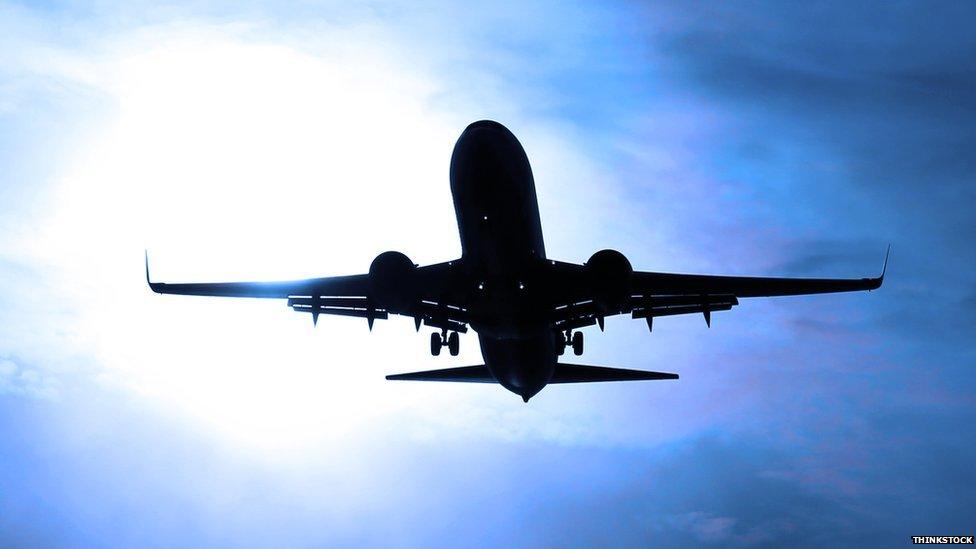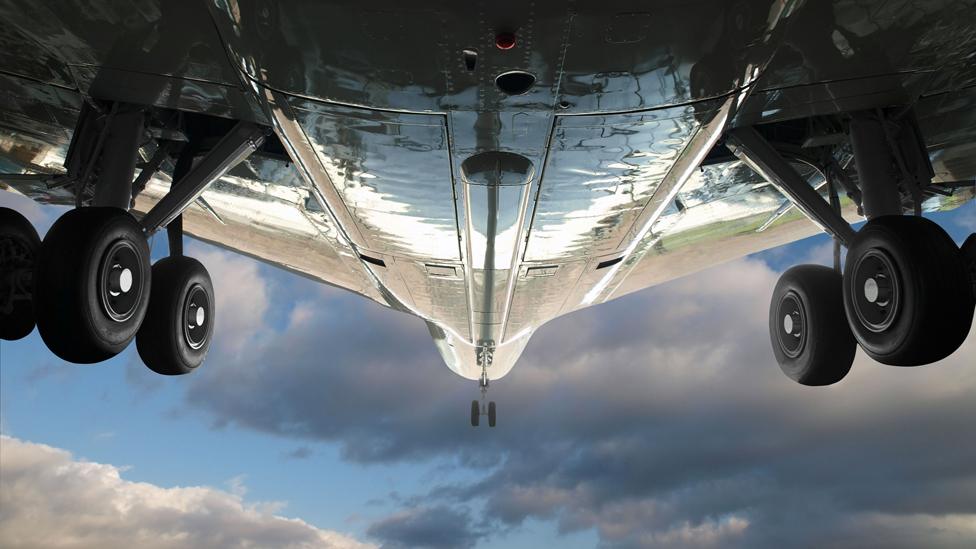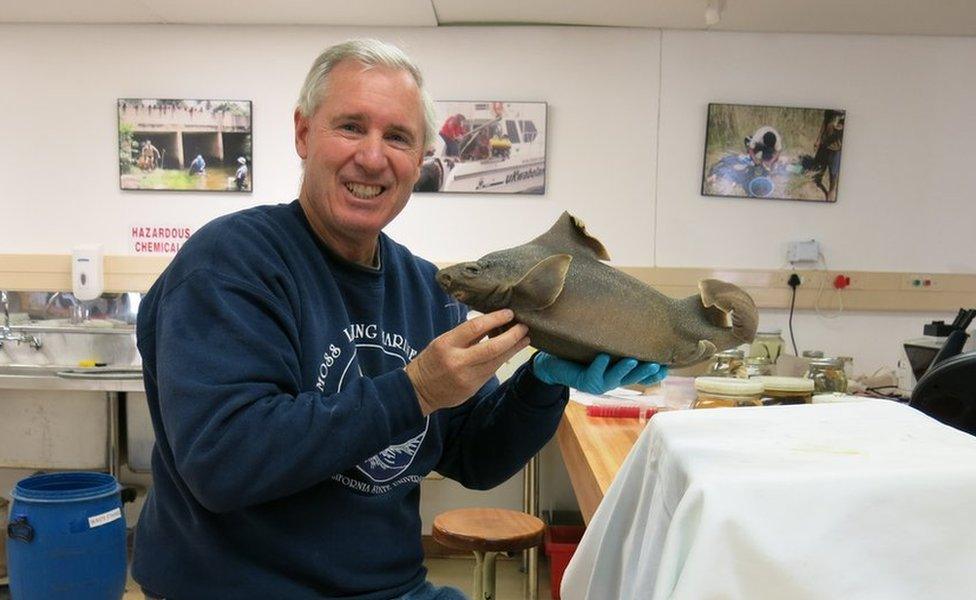The medical conundrum of plane stowaways
- Published

A man is fighting for his life after apparently surviving stowing away in the undercarriage of a 5,600-mile (9,000km) flight to London. Given extremely low temperatures and a lack of oxygen, how was he able to survive the journey?
Flights from Johannesburg to London take about 11 hours. Boeing 747s tend to cruise at a height of between 30,000 and 40,000ft (9,100m and 12,200m).
The standard ambient temperature at 35,000ft (10,700m) is around -54C. Oxygen levels drop to about 26% of those at sea level, external. The odds of survival for a stowaway who climbs into the small space above a wheel seem tiny, assuming they're not crushed to death when the wheel draws up or they don't fall out as it lowers ahead of landing.
But a 24-year-old man is currently in a critical condition in a west London hospital, having seemingly endured conditions that should in theory rapidly kill any person. The body of another man was found on a roof a few miles from Heathrow. Police are investigating whether the second man had climbed on to the same plane.
"It's unbelievable that anyone could survive those conditions." says Jack Kreindler, a high-altitude physician at the Centre for Health and Human Performance. "People spend up to three months acclimatising for the top of Everest. Even that's completely different. It's gradual and the clothing is designed for it and they could maybe survive a night at most, and these are people right at the genetic limits - they're not normal.
"If someone were to ask the odds of surviving in a wheel well from Johannesburg to London, there's not one expert who'd give them a chance." Kreindler says that, if it turns out the man survived the flight without the use of an oxygen supply, medics would be very keen to study his genetic make-up.
David Learmount, consulting editor at Flightglobal.com, doubts whether it's even possible, external. "If someone is to survive as a stowaway then they have to get into an area of the plane that is pressurised and heated," he has said. This is highly unlikely in this case - for obvious reasons there is no way of accessing the pressurised parts of the plane from the wheel well. Learmount thinks the survivor must have brought some oxygen in a container to make the journey remotely achievable.

The South Africa stowaway is not the first wheel well-climber to survive a jet flight. In fact, the rate of survival may be as high as about one in five, according to the US Federal Aviation Authority (FAA). But the lower the altitude the better your chances. At the highest altitudes commercial flights reach, it's hard to explain how anyone could survive.
Is there anything to help would-be stowaways withstand the conditions? Tyre friction on takeoff might mean some heat radiates towards a stowaway, as can warm fluid in hydraulic lines within the compartment.
But these sources fade as the plane ascends, taking the temperature far below anything regarded as survivable. The wheel well on a 747 is protected from the elements during flight by flaps, but these are not pressurised, external, limiting protection from the cold. There's no obvious way of getting into a space more conducive to life.
Healthy humans are able to regulate body temperatures at 36C to 37.3C in more normal conditions, but, according to the FAA, the limited oxygen supply at high altitude means this is no longer possible.
At this point people might start to become poikilothermic, research sponsored by the FAA, external says. This means their body temperature becomes more controlled by the external environment. A state "somewhat reminiscent" of hibernation occurs. The body's temperature can fall to 27C or even lower. Unconsciousness and lower heart and breathing rates occur.

The body would pump blood to the brain more efficiently and distribute it only to the automatic nervous system, in an effort to survive. This means less blood getting to the body's extremities. Frostbite is a severe risk, but the most vital organs could be saved, the theory goes.
When the plane nears the ground, the body gradually re-warms, the FAA adds. If the person avoids brain damage or falling out as the wheel lowers before touchdown, they might in theory survive.

Other extreme wheel well survival stories
1969 - Armando Socarras Ramirez, 22, managed to withstand the effects of a flight from Havana, Cuba, to Madrid, suffering frostbite but no major damage
1996 - Pardeep Saini, 23, stayed alive during a 10-hour flight from Delhi to London, but his brother Vijay died falling out of the aircraft as it approached Heathrow
2000 - Fidel Maruhi survived the 4,000-mile journey on a Boeing 747 from Tahiti to Los Angeles
2002 - Victor Alvarez Molina, 22, got through the four-hour flight on a DC-10 from Cuba to Montreal, Canada
2014 - Yahya Abdi, 15, stowed away in a Boeing 767 from San Jose, California, to Maui, Hawaii

But mention of a poikilothermic state is not "useful", says Ken Baillie, consultant in intensive care medicine at the University of Edinburgh. "This rather suggests that we revert to some evolutionarily ancient mechanism to survive extreme conditions, and I can't see any evidence to support that claim," he adds. "I think the reality is much simpler - if you are very cold, your brain takes longer to die."
The cold and lack of oxygen would quickly shut down the brain, "leaving you unconscious but technically alive", says Baillie. "It is worth saying that, in the unlikely event that someone does manage to survive a landing in a wheel bay, even if they don't have a pulse, an ambulance should still be called because there is a small chance that they can still be saved."
The full medical condition of the stowaway from South Africa on arrival has not been divulged and there is no detail of what he was wearing. But there are some hopeful precedents. In 2010 a 20-year-old Romanian survived a flight from Vienna to Heathrow stowed in the undercarriage, but the private jet flew below 25,000ft (7,600m) due to bad weather.

More from The Magazine

Jose Matada's body was found in Portman Avenue, Mortlake, in September 2012, soon after a flight from Luanda, Angola, flew over the residential area. He had no identity papers on him and no-one had reported him missing.

In 1969, 22-year-old Armando Socarras Ramirez survived in the wheel well of a DC-8 from Havana, Cuba, to Madrid, Spain, wearing only light clothes.
"Little by little I felt cold, sleepy and had great pains in my ears," he said. "I must have fallen asleep. I don't know anything more. I know I woke up once thinking it was terribly cold."
The cruising altitude on Socarras Ramirez's flight was 29,000ft (8,800m) - lower than last week's Johannesburg-to-London flight. At this height the standard ambient temperature is -43C - still unbearable-sounding but warmer than the stowaway from South Africa would have experienced. The oxygen level is also higher, at about 33% of that at sea level. So, overall, Socarras Ramirez's odds were better than last week's stowaway.
Even then, he suffered frostbite and medics were surprised he had no long-term organ damage. Socarras Ramirez, who left Cuba to flee Fidel Castro's communist government, which he did not support, now lives in West Virginia. His survival was described in the press as a "miracle".
A more extreme example happened last year, when 15-year-old Yahya Abdi apparently stowed away in a wheel well for a five-hour flight from California to Hawaii. The cruising altitude was said to be 38,000ft (11.600m), within the range of the 747 on the Johannesburg to London flight.
"[This] is one of three things - a hoax, a miracle or we're going to have to rewrite the textbooks if he actually did what he says he did," said US aviation expert John Nance, external.
And that flight lasted only half as long as the one from Johannesburg.

Also in today's Magazine: The man who keeps finding new species of shark

© Dave Ebert / PSRC
"When I was 10 years old I told my folks, 'I'm going to travel the world and study sharks,' says Dave Ebert. So far, he's discovered 24 new species - and counting. READ MORE

Subscribe to the BBC News Magazine's email newsletter, external to get articles sent to your inbox.